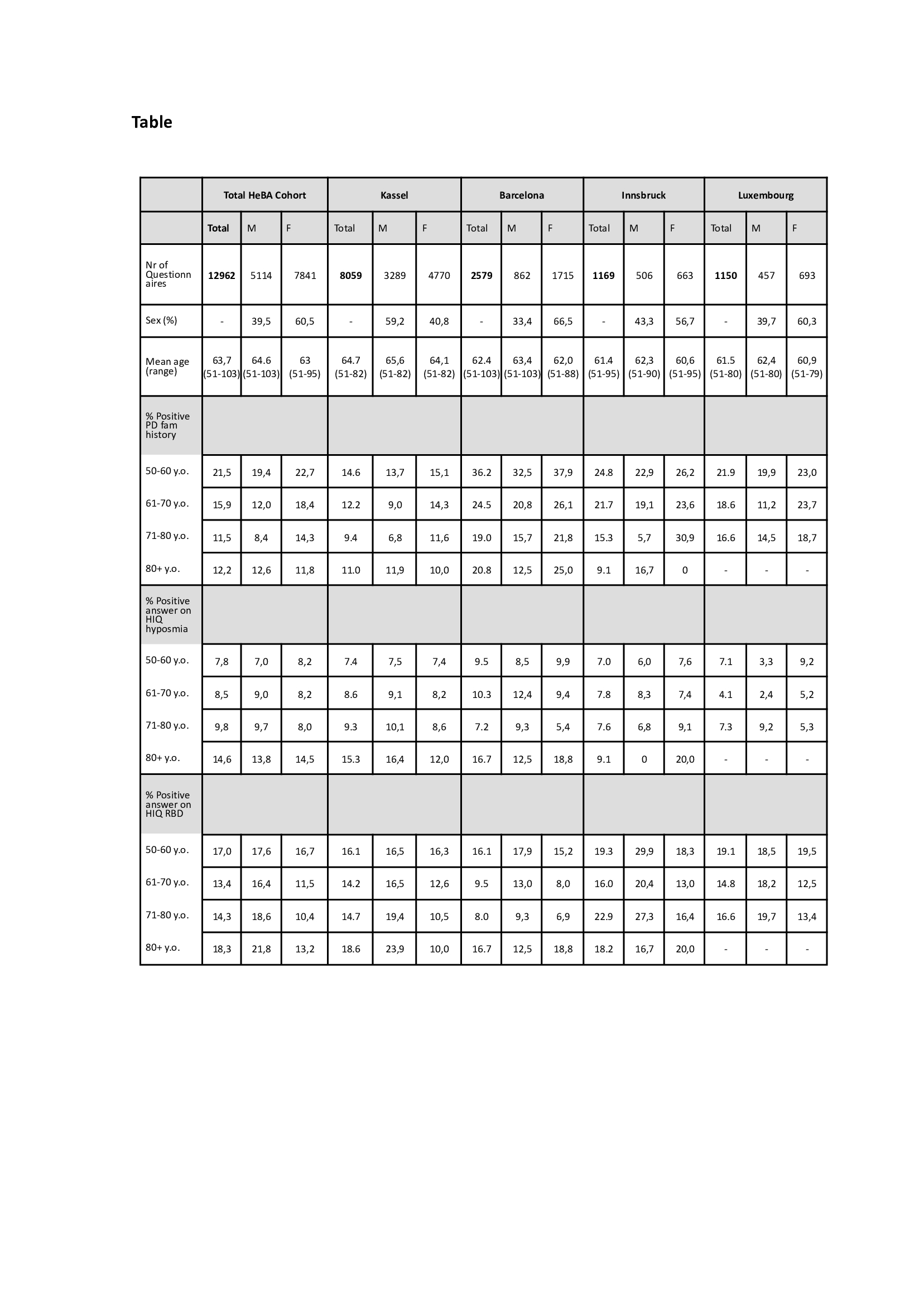Category: Other
Objective: To present the baseline data on common risk factors for Parkinson’s disease (PD) in the population-based cohort of the HeBA study (Ref Poster 1) and determine
the usefulness of a single question on smell deficit for depicting this risk factor for PD in the HeBA cohort.
Background: A positive family history of PD, smell loss, and REM sleep behavior disorder are well-established risk factors for PD and part of the criteria for prodromal PD. The University of Pennsylvania Smell Identification Test (UPSIT) has also been used as a screening tool for the early detection of PD. There is a lack of population-based studies investigating the feasibility and validity of remote surveys on these risk factors.
Method: The HeBA cohort currently consists of 12.962 ≥50-year-old healthy volunteers from the regions of Kassel (Germany), Innsbruck (Austria), Barcelona (Spain) and Luxembourg. The online HeBA questionnaire includes high-interest single questions (HIQ) regarding PD family history, smell loss, and dream-enacting behaviors followed by an UPSIT and in-person visit. We describe the baseline data and compare the answers to the HIQ smell loss to the UPSIT result adjusted for sex and age.
Results: The table shows the baseline demographics and the percentage of positive answers to the HIQ separated by age and sex. 15% of all participants answered positively to the HIQ on dream-enacting behaviors, 8% on smell deficits, and 17% on family history. Of those who already completed a UPSIT (n=3153), 20% had a result≤9th percentile. Younger participants reported more frequently having a family history of PD, whereas, with increasing age more participants answered positively to the HIQ on smell loss and dream enactment. Most participants were highly educated (44%) and lived independently (99%). The specificity of the HIQ on smell deficits was 87%, but having responded positively predicted a UPSIT≤9th percentile in only 39% of cases. Remarkably, 66% of the participants with a UPSIT ≤9th percentile did not notice smell deficits subjectively according to the HIQ.
Conclusion: Our results show the feasibility of performing a multi-centre online screening study on risk factors for PD. Among sites, similar frequencies of the high interest risk factors were observed. Subjects endorsing PD-risk symptoms will undergo an in-person assessment and be followed prospectively to validate the predictive value of the HIQ and the UPSIT.
To cite this abstract in AMA style:
A. Garrido, C. Horlings, C. Vega, S. Schade, S. Ghosh, K. Rege, R. Rawal, T. Marques, P. Mahlknecht, C. Gomes, C. Pauly, D. Mcintyre, K. Seppi, MJ. Martí, C. Trenkwalder, E. Tolosa, W. Poewe, V. Satagopam, R. Krüger, B. Mollenhauer. From the Healthy Brain Ageing (HeBA) Cohort: Frequency of key risk factors for Parkinson in a European Cohort [abstract]. Mov Disord. 2023; 38 (suppl 1). https://www.mdsabstracts.org/abstract/from-the-healthy-brain-ageing-heba-cohort-frequency-of-key-risk-factors-for-parkinson-in-a-european-cohort/. Accessed December 27, 2025.« Back to 2023 International Congress
MDS Abstracts - https://www.mdsabstracts.org/abstract/from-the-healthy-brain-ageing-heba-cohort-frequency-of-key-risk-factors-for-parkinson-in-a-european-cohort/

